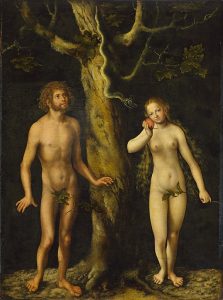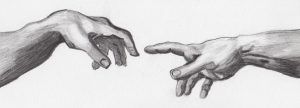by Lois Tverberg
Then God said, “Let us make man in our image, in our likeness, and let them rule over the fish of the sea and the birds of the air, over the livestock, over all the earth, and over all the creatures that move along the ground.” So God created man in his own image, in the image of God he created him; male and female he created them. (Genesis 1:26-27)
In examining the creation account, we see that many of its profound ideas are only clear when read within its Eastern cultural way of communicating truth through images and relationships.1 A main point of the epic is to describe the creation of mankind, and to describe man’s unique relationship to God and to his world. Understanding this idea, as well as the revolutionary concept that we are made “in the image of God” is foundational to many later teachings in the Scriptures, including those of Jesus.
The Significance of Man
Reading Genesis in Hebrew reveals many wonderful wordplays that show the relationship of man to the rest of creation. The word for ground is adamah, and of course the first human is called Adam.
The name perfectly fits the scene because God formed Adam from the adamah, and Adam’s skin is red (adom, in Hebrew), like the ground. Adam is given the task of working the adamah, and when Adam dies, he will return to the adamah. God declared that because he sinned, “dust you are and to dust you will return” (Gen. 3:19).
What does the idea mean that we were made “in the image of God,” b’tzelem elohim? To an ancient person, a god’s “image” was its physical representation on earth. Idols were the images of the gods, as well as physical objects of worship like the sun and moon.
Kings were also often said to be the “images” of gods — they were the representative of a god on earth, with the belief that the gods reigned over their people through the king’s commands. This idea seems to be a part of the intent of Genesis, because right after humanity was said to be in the image of God, humanity was given the task of ruling over the earth (Gen. 1:28). We were given the job of being God’s caring presence, fulfilling his will toward the rest of creation.
From these two ideas, that Adam comes from the adamah, but is the representative of God on earth, one rabbi made a perceptive observation. He said, “A person should always carry two slips of paper, one in each pocket. On one should be written, ‘I am but dust and ashes,’ and the other, ‘All of creation was made for my sake.'”2
We should see both our frailness and short life on this earth, and our “feet of clay” — our tendency to sin — but yet we should also remind ourselves that we have a unique relationship to God and authority over all the earth. Acknowledging both truths in balance will keep us from feeling either too arrogant or too insignificant.
All Humans Bear the Image of God
The implications of man as the “image of God” comes up repeatedly in the Bible. After the flood, God made new pronouncements about the penalty for violence and said, “And from each man, too, I will demand an accounting for the life of his fellow man. Whoever sheds the blood of man, by man shall his blood be shed; for in the image of God has God made man” (Gen. 9:5-6). The idea here is that an assault on any human is an affront on God himself, and God will be sure to hold the perpetrator accountable.
All violence and even insults are ultimately against the God who made us. One amusing rabbinic parable points this out:
A famous rabbi was out riding and was feeling elated because he had studied much Torah. There he chanced to meet an exceedingly ugly man who greeted him, “Peace be upon you, rabbi.” He, however, did not return his greeting but instead said to him, “Racca! (empty one or good for nothing) How ugly you are! Is everyone in your town as ugly as you are?”
The man replied, “I do not know, but go and tell the craftsman who made me, ‘How ugly is the vessel that you made.'” When the rabbi realized that he had sinned, he dismounted from the donkey and prostrated himself before the man and said to him, “I submit myself to you, forgive me!”3
The point of the parable is that any time we insult someone, we are not just defaming that person, but the God who made him. After all, he is the one who fashioned him according to his specifications. Even more importantly, if our creator made each human to reflect his own image, when we call another “ugly,” we are insulting God as well. We actually are sinning twice, by calling God not only a poor artist, but ugly too!
James also uses the idea of the “image of God” to point out the incongruity of worshipping God while insulting others:
With [our tongue] we bless our Lord and Father, and with it we curse men, who have been made in the likeness of God; from the same mouth come both blessing and cursing. My brethren, these things ought not to be this way. (Ja. 3:9-10)
Every human being should be treated as a special creation of God, because all are precious to him. This idea of the enormous value of human life also was part of the teaching of the rabbis:
Every individual is equally significant before God, since every man was created in his image. Therefore man was created on his own, to teach you that whoever destroys one soul is regarded by the Torah as if he had destroyed a whole world, and whoever saves one soul, is regarded as if he had saved a whole world.4
Male and Female He Created Them
 Another wonderful idea about humanity can be found in a Hebraic reading of the story of the creation of Eve from Adam. The word we have traditionally translated as “rib,” tzela, is never used this way in the rest of the Bible. Rather, it always means “side” and when the phrase “one side” of something is used, it means one half, or one face of a building or object. (See Ex. 25:12, Ex. 26:26 or Ex. 37:3.)
Another wonderful idea about humanity can be found in a Hebraic reading of the story of the creation of Eve from Adam. The word we have traditionally translated as “rib,” tzela, is never used this way in the rest of the Bible. Rather, it always means “side” and when the phrase “one side” of something is used, it means one half, or one face of a building or object. (See Ex. 25:12, Ex. 26:26 or Ex. 37:3.)
When God takes out of Adam echat mitzelotav — literally “one of his sides” — the picture is really that somehow God split Adam in half and formed one half into Eve. Adam then calls her “flesh of my flesh, and bone of my bone,” not just “one of my bones.” The image is that one human was separated into man and woman so that they could have companionship with each other. The complementarity between men and women is inherent in the way they were formed by being taken apart from each other, so that one supplies what the other one lacks.
This actually solves a mystery in the text. In Genesis 1:27, God created both male and female, but in Genesis 2:24, it appears that Eve is created after Adam. How could this be so? Because both were present in the first person, and the woman appears after being separated from the man.
Supporting this, throughout the entire story, the word “adam” is a generic term meaning “human,” not specifically male. In Genesis 5:2, it says so explicitly: “He created them male and female and blessed them. And when they were created, he called them adam.”
In the original Hebrew text, all references to the first human are neutral until God takes some of Adam’s flesh and makes a woman — ishah, in Hebrew. Only at that point is Adam called ish, a man. The Hebrew word ishah hints at her origins from within the ish, something that we can mimic in English, with the words “man” and “woman.” Interestingly, Adam is never called an ish until the ishah has been separated from him. The text seems to imply that male and female cannot define themselves fully as human without the other.5
God’s Intention for Marriage
The next verse about marriage deepens this metaphor even more. By saying, “For this reason a man will leave his father and mother and dabaq (be united, cleave) to his wife, and they will become one flesh” (Gen. 2:24). It is describing how in marriage, a man and a woman together become what God intended from the very beginning, when the separation of one half from the other half is reversed.
 Even the word we translate as “cleave” or “hold fast” in this verse, dabaq, has a lovely picture behind it. The word dabaq also can mean “to fall in love with” as when Shechem “was deeply attracted to,” dabaq, Dinah in Genesis 34:3.
Even the word we translate as “cleave” or “hold fast” in this verse, dabaq, has a lovely picture behind it. The word dabaq also can mean “to fall in love with” as when Shechem “was deeply attracted to,” dabaq, Dinah in Genesis 34:3.
1 Kings 11:2 also says that “Solomon dabaq his foreign wives in love,” which one version renders, “Solomon was irresistibly attracted to them” (New English Translation). Putting all of this together, Genesis 2:24 is saying that the reason women and men fall in love and marry is from their desire to return to this first oneness, both physically and spiritually, that was in God’s design from the very beginning.
This clarifies Jesus’ words about God’s intentions for marriage:
“Haven’t you read,” he replied, “that at the beginning the Creator ‘made them male and female,’ and said, ‘For this reason a man will leave his father and mother and be united to his wife, and the two will become one flesh’? So they are no longer two, but one. Therefore what God has joined together, let man not separate.” (Mt. 19:3-6)
Jesus is describing God’s original desire for marriage, that it would be a permanent union, giving companionship and completion to both persons. When he says about divorce that “it was not this way from the beginning,” he is looking beyond the law of Moses and seeing God’s perfect plan in Genesis. He concludes that when God himself puts together what he separated at first, no one should try to tear it apart.6
Imitating the One Whose Image We Bear
If all of us have God’s image within us, how should it impact the way we live? One rabbinic commentary on Genesis answers this question with a delightful story:
When creation was all but ended, only humanity was left to be created. God began to say, ‘Let us make man in our likeness,’ but some protests arose in heaven! First Truth came and fell before God’s throne, and in humility exclaimed, “Please, O God, do not call into being a creature who is beset with the vice of lying, who will tread truth under his feet!” Peace also agreed, and said, “Why, O Lord, shall this creature appear on earth, a creature so full of strife and contention, to disturb the peace and harmony of thy creation? He will carry the flame of quarrel and ill-will in his trail; he will bring about war and destruction in his eagerness for gain and conquest.”
While they were pleading against the creation of man, another voice was heard, the soft voice of Mercy. “King of the universe,” the voice exclaimed in all its mildness, “if you create a being in thy likeness, it will be a noble creature striving to imitate thy attributes by its actions. I see man now with God’s breath in his nostrils, seeking to perform his great mission, to do his noble work. I see him approaching the humble hut, seeking out those who are distressed and wretched to comfort them, drying the tears of the afflicted and despondent, raising up them that are bowed down in spirit, reaching his helping hand to those who are in need of help, speaking peace to the heart of the widow, and giving shelter to the fatherless. Such a creature cannot fail to be a glory to his maker.’ The Creator approved of the pleadings of Mercy, and called man into being.7
This story is saying that when humans show the kindness and compassion of our creator, then we reach our true potential as his creation by reflecting his image on earth. It points out man’s potential for good, even while acknowledging man’s potential for evil.
Of course the only person who truly lived up to this was Jesus: he completely reflected the image of God without succumbing to evil. Interestingly, Paul says that he was the “very image of the invisible God” (Col. 1:15). Because he is the Son of God, he reflected the character and nature of God in a way unparalleled by any mere man.
Through his work on earth, God’s sacrificial love and desire to forgive was revealed like never before, when it was portrayed in human form. He is our model for life as it was meant to be lived. By becoming transformed into his image, we achieve our true potential for reflecting the glory of God.
For those God foreknew he also predestined to be conformed to the likeness of his Son, that he might be the firstborn among many brothers. (Rom. 8:29)
[We] are being transformed into his likeness with ever-increasing glory, which comes from the Lord, who is the Spirit. (2 Cor. 3:18)
You were taught, with regard to your former way of life, to put off your old self, which is being corrupted by its deceitful desires; to be made new in the attitude of your minds; and to put on the new self, created to be like God in true righteousness and holiness. (Eph. 4:22-24)
~~~~
1 See the article “Thinking Hebraically About God’s Creation.”
2 Rabbi Simcha Bunam, who lived in the early 19th century, as quoted by J. Telushkin, The Book of Jewish Values, (Bell Tower, New York, 2000), p.185.
3 Babylonian Talmud, Ta’an. 20a-b1, quoted by Brad Young in The Parables: Jewish Tradition and Christian Interpretation, (Hendrickson, Peabody, MA, 1998), p. 9.
4 Mishnah, Sanhedrin 4:5 The date of the saying would be between 200 BC – 200 AD, which could be either before or after Jesus’ time.
5 Nahum Sarna, JPS Commentary on Genesis. (Jewish Publication Society, New York, 1989), p. 23.
6 David Daube, The New Testament and Rabbinic Judaism (Hendrickson, Peabody, MA, 1998) p. 71-76. One saying went so far as to say that “A man without a wife is half a man” stressing the importance of marriage. Jesus, however, says that not all are called to it, and some put it aside out of dedication to God’s work (Matt. 19:11). See New Light on the Difficult Words of Jesus by David Bivin (En-Gedi, Holland, MI, 2005) for more.
7 Adapted from Genesis Rabbah 8, which dates from the 5-6th centuries AD.
Photos: Laura Dewilde on Unsplash, Lucas Cranach the Elder [Public domain], freestocks.org on Unsplash





